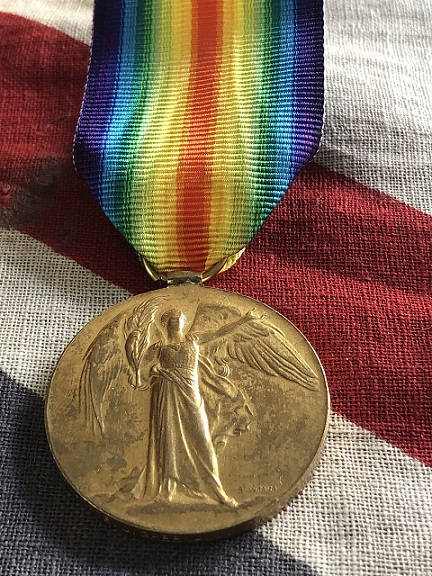33rd BATTALION AIF
Private: 3260 Charles William SULLIVAN. "Charlie"
Born: 28th July 1890. Murree, Rawalpuidi, India.
Married: 24th January 1908. West Partings, Bo Ness, West Lothian, Scotland.
Wife: Sarah Elizabeth Sullivan. nee: Hunter. (1888-1984)
Died: 31st March 1918. Died of Wounds. Villers-Bretonneux, France.
Father: John Sullivan. (1855-1923)
Mother: Mary Ann Sullivan. nee: Collins. (1867-1957)
INFORMATION
Charles William Sullivan enlisted with the AIF at the Central Recruitment Depot at the Royal Naval House, Grosvenor Street, Sydney on the 30th April 1917 before we was en-trained to the Liverpool Army Camp where he was allocated to the 8th Reinforcements 33rd Battalion AIF.
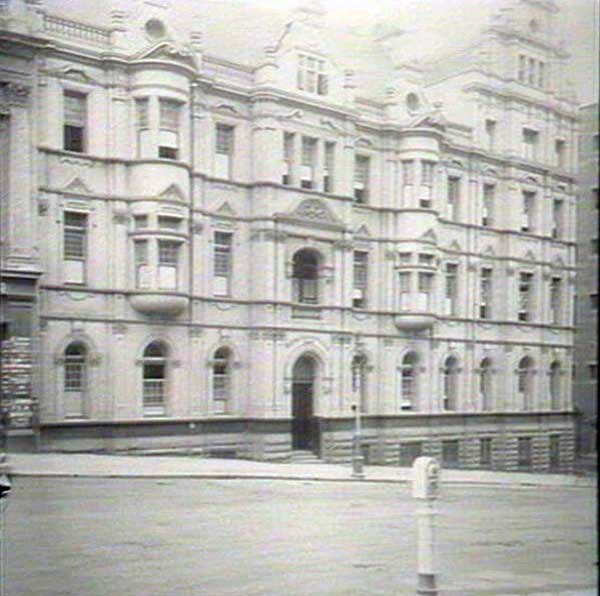
Charles embarked from Sydney on board HMAT A16 "Port Melbourne" on the 16th July 1917 and disembarked at Liverpool, England on the 16th September 1917 where the 8th Reinforcements were marched in to the 9th Training Battalion at the Durrington Army Camp where he was promoted to the rank of Acting Corporal. Charles was Charged with being AWL from the 22nd of November unit the 24th November 1917. Award Forfeits 3 Days Pay by Major: Brent Burnell RODD.
Charles reverted in Rank from Acting Corporal to Private on the 17th January 1918 as the Reinforcements proceeded overseas for France via Southampton. The Reinforcements disembarked at Rouelles the next morning where they went into billets for the next 2 nights before they were marched out to the lines where they were taken in in strength with the 33nd Battalion on the 22nd January 1918.
COUNTER ATTACK OPERATION. AFTERNOON AND EVENING MARCH 30TH, 1918.
33RD BATTALION A.I.F
At 10;30 a.m. on March 30th the 33rd Battalion moved from billets in CACHY to a position of readiness on the south Western edge of the BOIS D'AQUENNE. The enemy shelled CACHY from 10 a.m. but we suffered no casualties. At 2;15 p.m I reported to you at the Brigade Report Center at H.33,0,35,40 and received your orders to capture and establish a line from the Copse immediately South of the first c in MARCELCAVE to AUBERCOURT, and to capture AUBERCOURT which was in possession of the enemy. The 33rd would work in conjunction with the 12th Lancers, who were 400 strong, and would have the 34th in support.
The following orders were issued by me verbally to Company Commanders at 2;45 P.M. "B" Company Lieutenant: 5017 John Graham Antill POCKLEY will establish a line from the Oppue just South of the first C in MARCELCAVE to a point 100 yards east of the Crossroads to V.14.b. "A" Company Captain: John Lovelock FRY will establish a line from 100 yards East of the Cross Roads in V.14.b. to V.20.b.20.00. "D" Company Captain: James William SHREEVE. will capture AUBERCOURT and establish a line on the Eastern and Southern sides of the village. As DEMUIN is held by the enemy particular attention is to be paid to the roads loading over to do LUCE from BEMUIN and COUXCELLES. "C" Company Captain: Walter John Clare DUNCAN will be in reserve in the valley South East of the BOIS DE HANGARD and to be ready to capture DEMUIN.
Battalion Headquarters will be the Reserve Company "D" Teams, according to S.S. 156, will not take into action but will be sent to BLANCY TRONVILLE. At 3;10 p.m the Battalion marched under the command of Major: Francis George GRANT. from BOIS D'AQUENNE and moved across country to the West of VILLERS-BRETONNEUX - AUBECOURT road in U.12. This position was reached at 4;35 p.m. At 3;00 p.m I sent forward two patrols from the Platoon of the 9th Corps Cyclists to reconnoitre North and South of the wood East of BOIS DE HANGARD and then as far forward towards AUBERCOURT and MARCELCAVE as possible. I regret to report that the Platoon Commander Lieutenant: Phillip Charles GRATWICKE was killed.
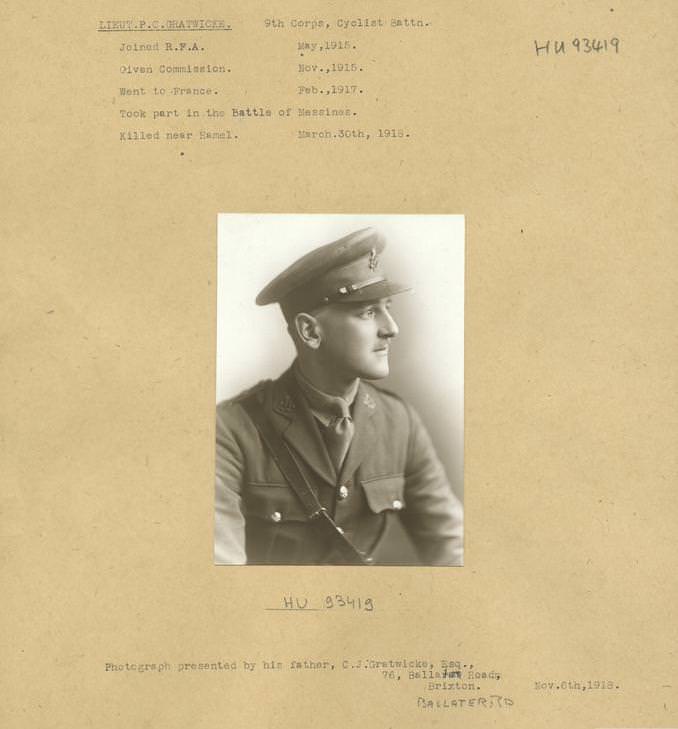
Lieutenant: Phillip Charles GRANTWICKE. 9th Corps, Cyclist Battalion. Killed in Action 30th March 1918.
The 12th Lancers proceeded the Battalion and reached the wood East of BOIS DE HANGARD at about 4;15 p.m.(This wood was in future be referred as LANCERS WOOD) My Adjutant, Scout Officer and Cavalry Liaison Officer went ahead with the Cavalry and reconnoitre the position. On our way to LANCER WOOD we passed several bodies of troops particularly had recklessly entrenched in queer places and large parties of stragglers. On reaching the wood we found the whole front line garrison East of LANCER WOOD withdrawing although there was no hostile fire of any kind and no signs of attack. I met two Brigadiers and a Battalion Commander in the wood and informed them what was happening at once. This they promised to do. The Cavalry Commander also helped in this matter by sending a Squadron dismounted to re-establish the line. The infantry went forward with the cavalry but in a reluctant manner. During the whole time we sore forward men constantly leaving the line. The seemed to be no effort to check this straggling.
It was a proud privilege to be allowed to work with such a fine Regiment as the 12th Lancers. Their approach march instilled in the mementos confidence and enthusiasm and I am glad to say greatly counteracted the effect of so much straggling. They lost no time in effectively clearing LANCERS WOOD and get there just in time as the enemy had obtained a footing on the southern and South Eastern edges. The Lancers protected the edges and allowed us to move forward to the attack. On seeing the cavalry there the enemy shelled LANCER WOOD very heavily, chiefly with 5.0s. paying particular attention to our fringes. Fairly heavy casualties to horses were inflicted there, the horses were soon led from the wood to a position West of the VILLER-BRETONNEUX - AUBERCOURT Road. The discipline during the heavy shelling was a subject lesson. During the attack the cavalry protected both our flanks, the left with two Machine Guns. They withdrew at about 7.00 p.m.
All ranks were eager to give every possible help to us, throughout there was whole hearted cooperation. The experience gained in this our first operation with cavalry was invaluable. One was able too judge of the splendid work they are doing for the Army at this present time and they cannot be too highly praised. The 33rd Battalion moved forward from the position of assembly at 3:00 p.m. The formation adapted by Companies was as follows; One Platoon in extended order, followed by two Platoons in line in Artillery formation; the fourth Platoon in reserve also in Artillery formation.
"B" Company moved along the Northern edge of LANCER WOOD and widened its front on clearing the wood. "A" Company moved throughout the wood. Owing to enemy shelling while moving through, the whole company was extended into three lines and resumed normal formation on clearing the wood. No casualties were sustained in the wood. "B" Company worked in single file along the brindle track near the Southern edge of the wood and formed up under cover of the terraced bank on the South East edge. Three casualties were sustained on entering the wood. "C" Company formed up on the sunken road in U.18.a. and not where was first ordered, owing to the hostile shelling.
The movement forward was splendidly carried out. On the right slight opposition was en counted but easily disposed of. no real opposition was not until we were about 200 yards clear of the wood when all three Companies came very heavy machine gun and rifle fire. They deployed at once and moved forward without flinching. All ranks displayed the greatest determination and eagerness to get to the Bosch with the bayonet, this eagerness was to some extent responsible for the heavy casualties as the principle of advancing under covering fire was not sufficiently observed. On the Left most progress was made in spite of heavy losses, and the enemy hurriedly retired but on discovering later in strength he reformed.

The enemy was well entrenched and in strong force as we had no artillery support his fire was consequently extremely heavy and unfortunately very accurate. Owing to such strong opposition we were not able to reach our objectives. The attached map shows approximately the line we established. The line is well sited and is a very good defensive position. With determined troops the enemy could easily be held, and any advance he attempted would be very expensive. Owing to casualties and to the wide front the Reserve Company to reinforce the right flank. This Company made good the gap between the right and center Companies. At the same time I requested the 34th Battalion which was in support in U.18.a. and U.12.c. West of the VILLERS-BRETONNEUX - AUBERCOURT Road, to send a Company to reinforce the left flank. I instructed Company Commander Captain: Telford Graham GILDER. to reconnoitre the position first and then move forward at 6.00 p.m. This Company advanced in two lines of two Platoons each and took the newly-made enemy trenches about 250 yards East of the line then held by us, capturing two light machine guns one of which was damaged, and four prisoners belonging to 91st Oldenburg Regiment.
Wilhelm CONZE; Company-Leader in the 91st Infantry-Regiment (03 Apr 1917-14 Oct 1917) Wounded, in Reserve Hospital in Gotha (23 Mar 1918-22 May 1918) Transferred to the Replacement-Battalion of the 91st Infantry-Regiment (22 May 1918-01 Jul 1918) Company-Leader in the 91st Infantry-Regiment (01 Jul 1918-30 Sep 1918) In French Captivity (30 Sep 1918-14 Feb 1920) Released from Captivity and back with the Processing-Office of the 91st Infantry-Regiment (14 Feb 1920-29 Mar 1920)
Captain GILDER withdrew and made good the gap between the left and center Company's. At 10:00 p.m. I requested the C.O. 34th Battalion to send two company's forward, one to the sunken road in U.18.a the other to a position 300 yards North East of LANCER WOOD. At 11:00 p.m. the enemy attempted a local counter attack against my left company but was repelled. Heavy rain fell from early in the afternoon till late at night. Walking over the ploughed fields under such conditions affected the Lewis guns and rifles. Every man was drenched to the skin and very cold, but this did not dampen his ardour. All maps were soon rendered useless and the writing of messages was extremely difficult. Our flanks were somewhat in the air, on our left the Warwicks were about 600 yard behind. The 66th Division were on our right, but touch with them was not obtained.
In order to secure my right flank the right Support company, of the 34th Battalion supplied a Platoon for patrolling and also to establish a post South of LANCER WOOD on the VILLERS-BRETONNEUX - AUBERCOURT Road. Our front was well protected by Vickers and Lewis Guns. We had five Vickers guns from the 9th Australian Machine Gun Company - two covered either flank and one the center, and we had 25 Lewis guns. We were relieved by the 10th ESSEX and the ROYAL WEST SURREY Regiment of the 18th Division this morning; the relief Battalion Headquarters were established at V.7.d.30.95. The Pre-arranged position was unatonable.
Lieutenant Colonel: Leslie James MORSHEAD.
Commanding 33rd Battalion A.I.F.
33rd Battalion War Diary
Charles was Wounded in Action on the 30th March 1918 during this action
German Spring Offensive casualty Victory Medal awarded to Private C.W. Sullivan, 33rd Battalion, Australian Imperial Force who died of wounds on 31st March 1918 and who was buried in Adelaide Cemetery, Villers-Bretonneux.
19th June 1918.
Informant; Corporal: 1242 George Easter STARK. Private: 3260 Charles William SULLIVAN was wounded on the 30th March 1918 by a bullet in the thigh during a counter attack. I was hit at the same time and he was still lying there when I left, but I saw him hit. I heard afterwards that he was taken down to the Dressing Station a Cachy and that he died there and that Lieutenant: McRea D Company, 33rd Battalion went to the Dressing Station to identify him. He was in No:1 Section D Company 13 Platoon. I do not know where he was buried, but sure to be near Cachy. He was an Englishman, a sailor and a South African War Veteran. His wife I believe lived in Scotland.
No: 1 Command Depot. SUTTON VENY.
19th June 1918.
Informant: Private: 1200 Alfred Henry MULHOLLAND. At Villers-Bretonneux, I saw Private: 3260 Charles Walter SULLIVAN wounded by a bullet through the stomach. I helped to take him to the Dressing Station but did not see him die or see where he was buried.
Ward 23. Harefield, England.
Victory Medal; (3260 PTE. C.W. SULLIVAN. 33-BN. A.I.F.)
Condition: Good Very Fine
Charles William Sullivan saw service as a Private (No. 3260) with the 33rd Battalion, Australian Imperial Force died of wounds on 31st March 1918 aged 27 and is buried in Adelaide Cemetery, Villers-Bretonneux. The son of John and Mary Ann Sullivan, husband of Mrs. Sullivan of 31 Bibby’s Lane, Bootle, Liverpool.

Adelaide Cemetery, Villers-Bretonneux.
Family Information
Charles was a Married 26 year old Fireman from 39 Ada Lane, Ultimo via Sydney, N.S.W. upon his enlistment with the AIF
Military Records


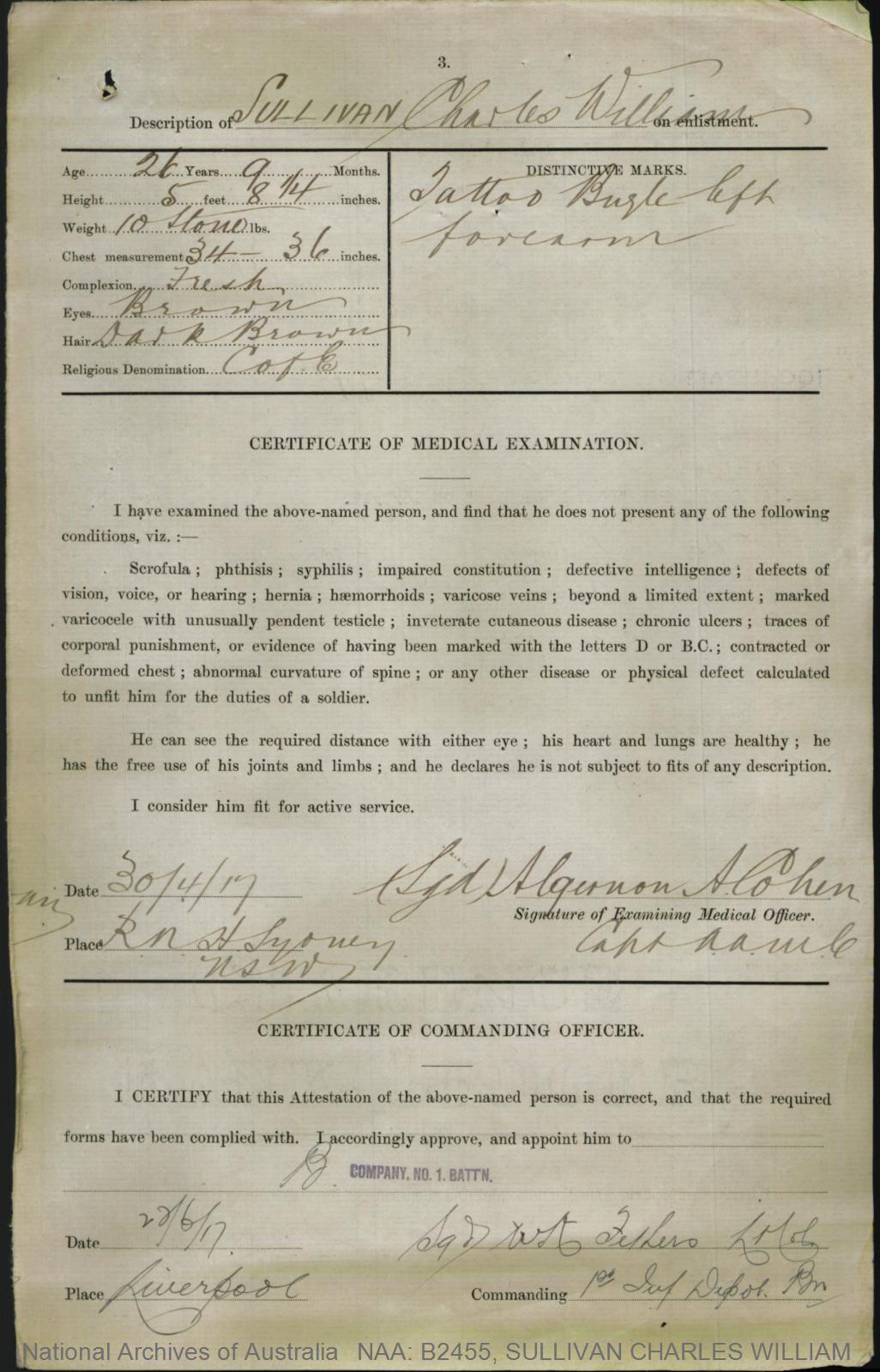



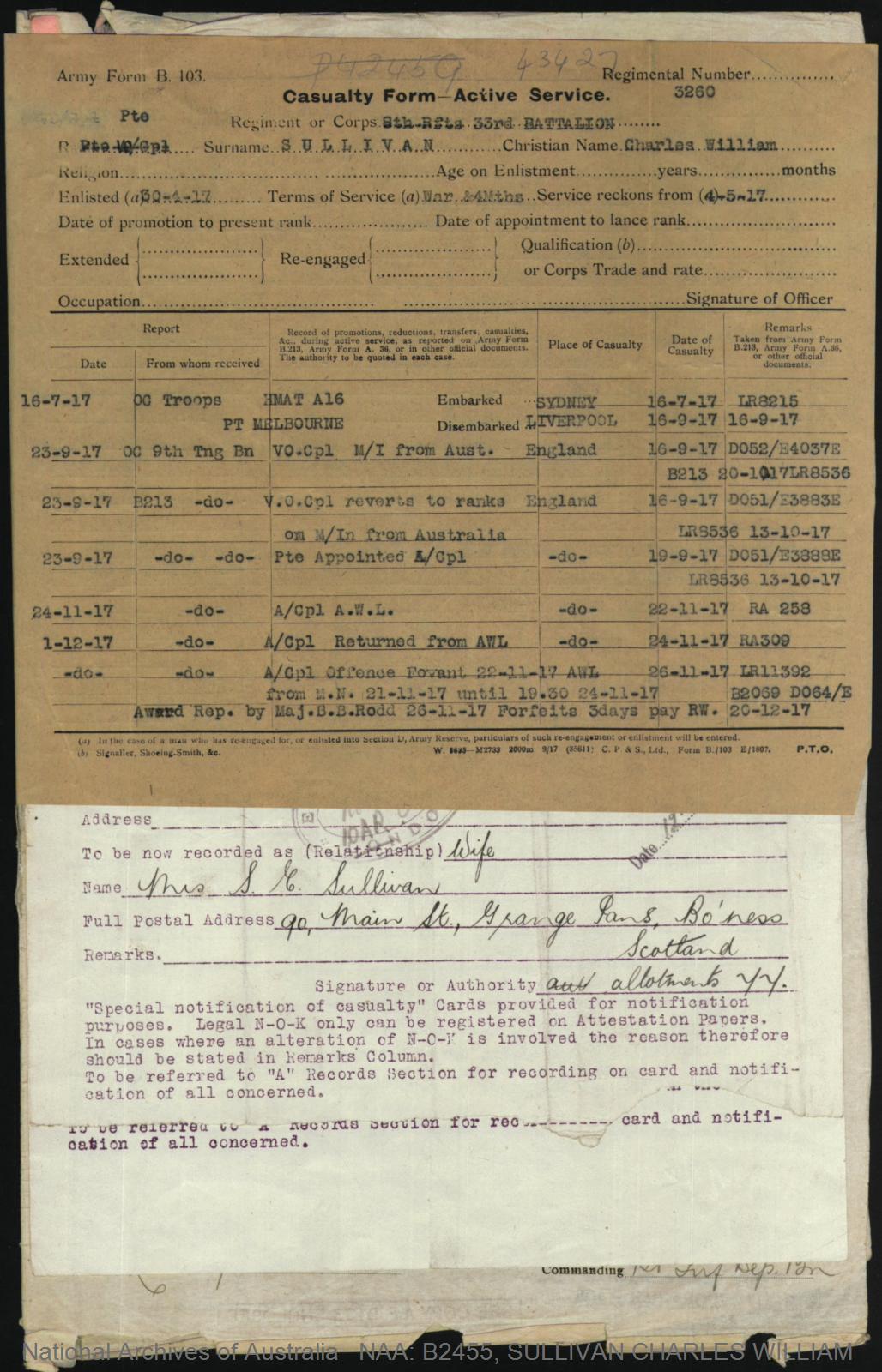

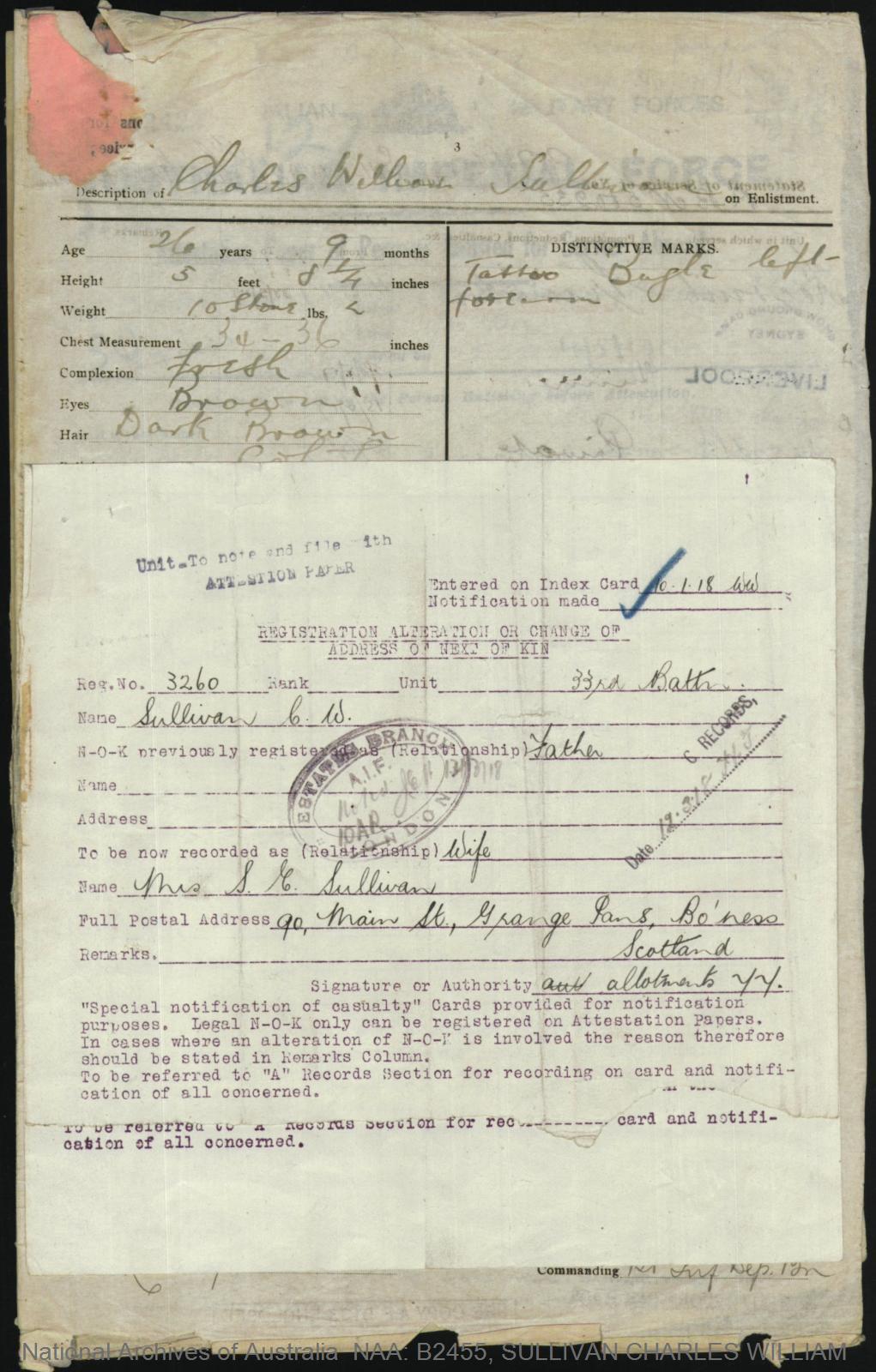
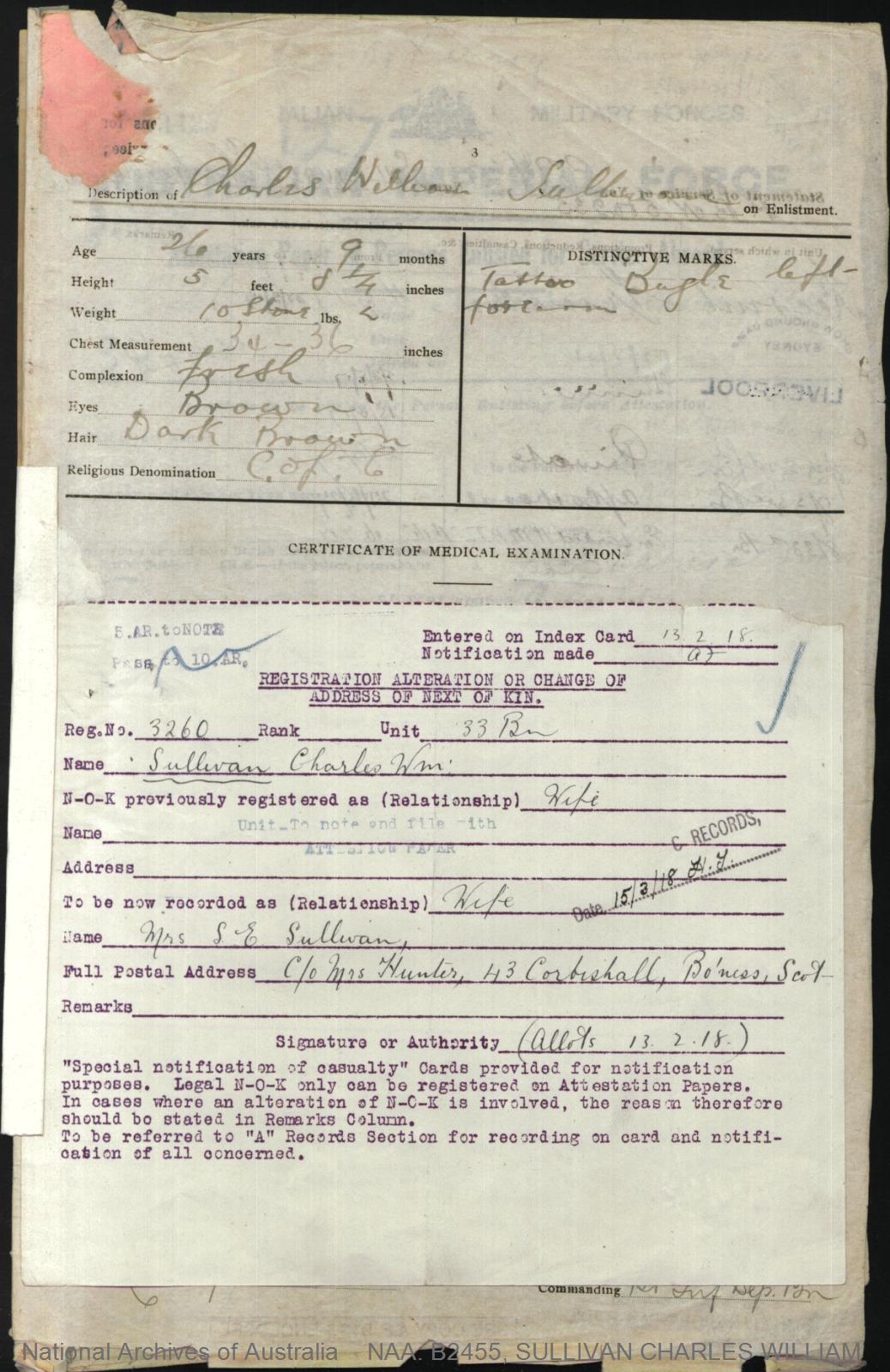
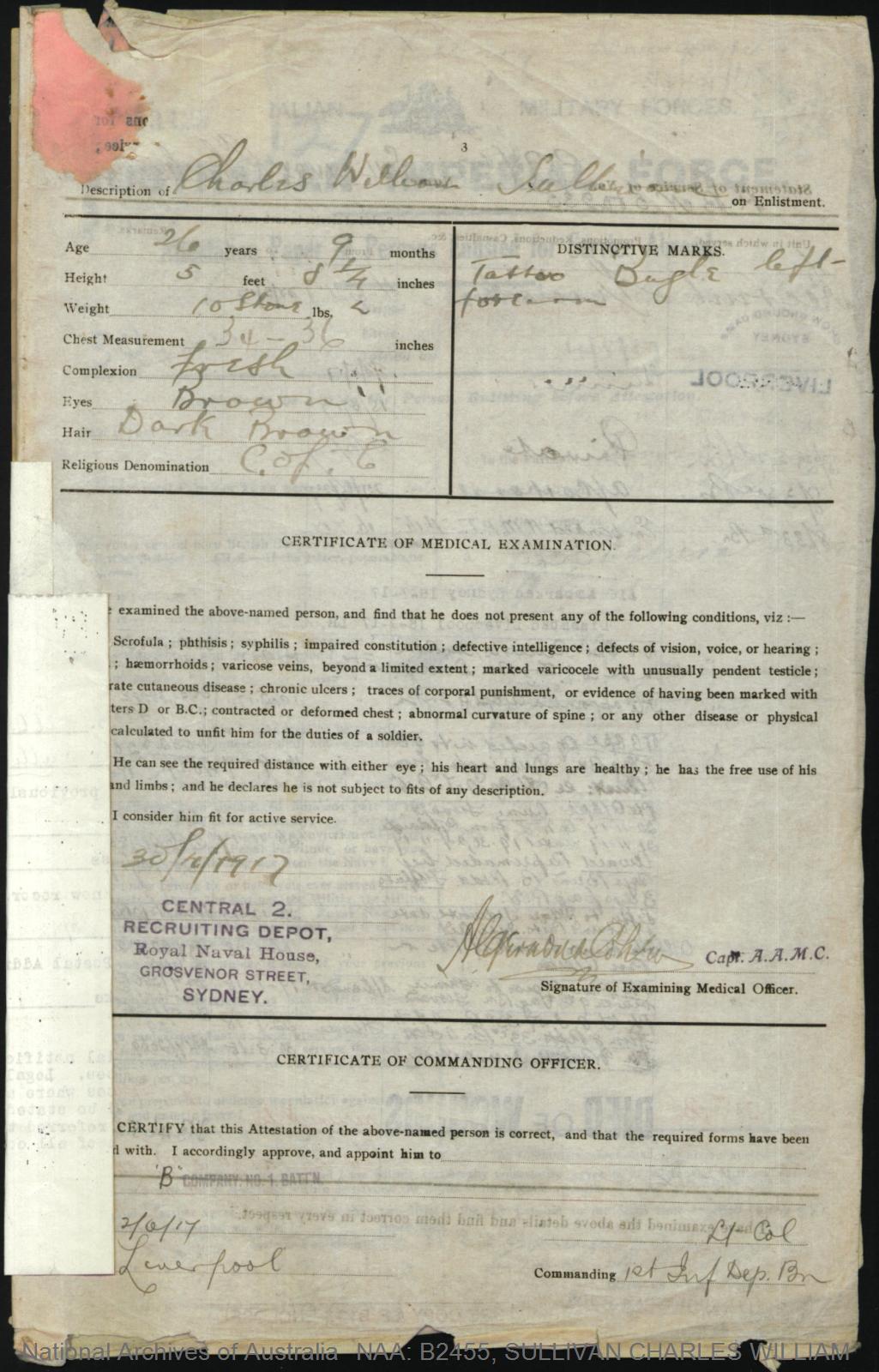
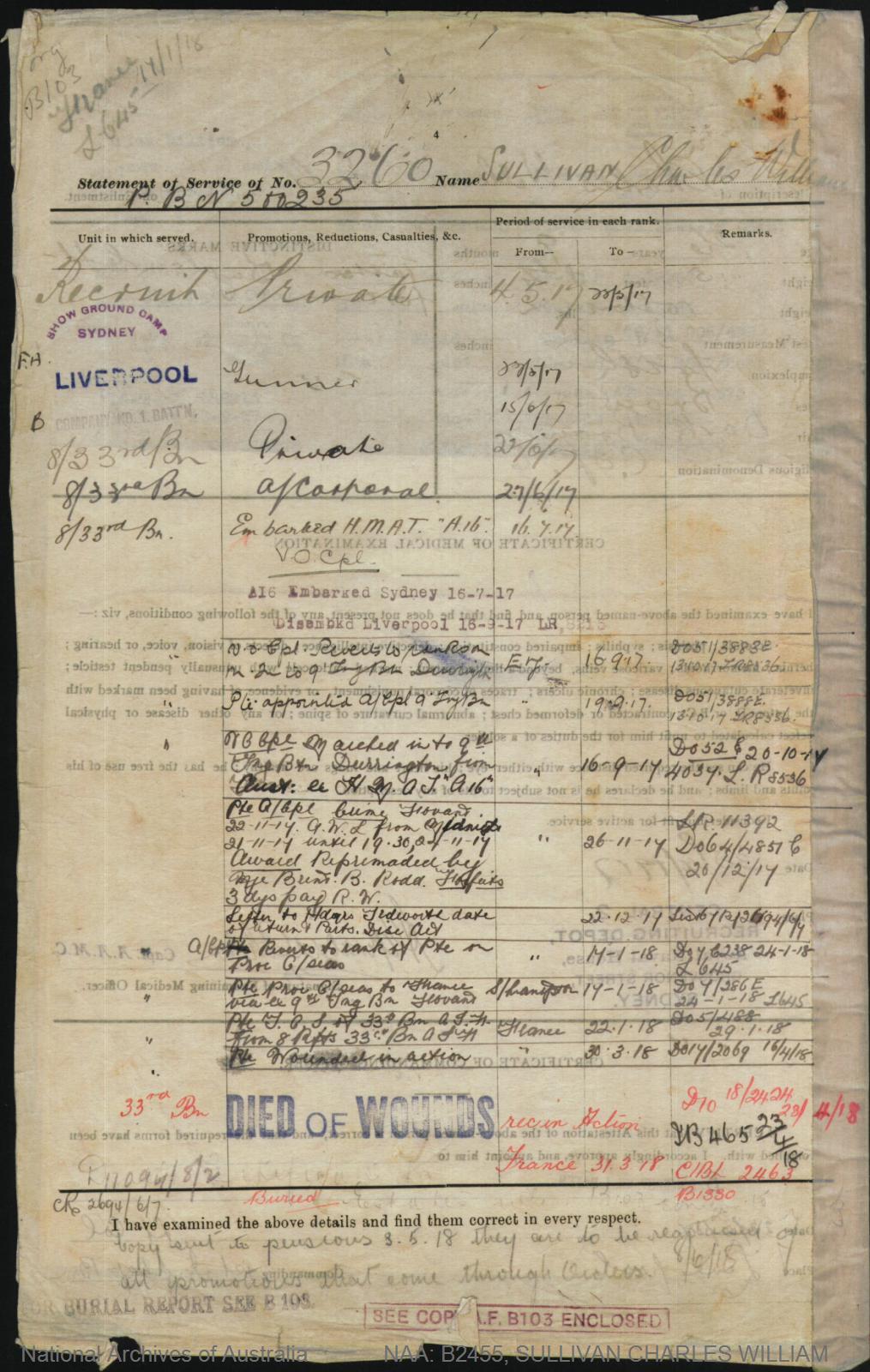
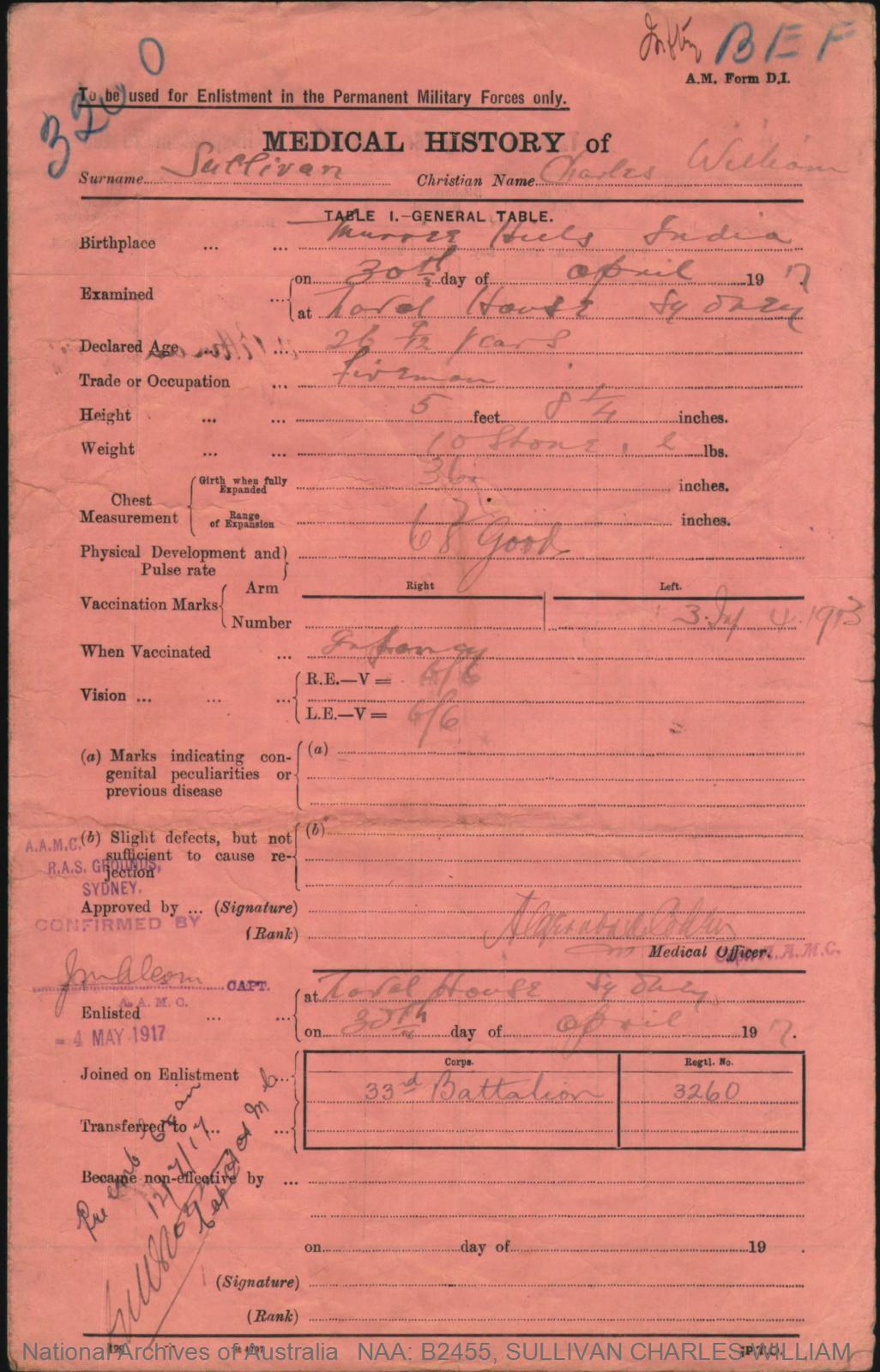
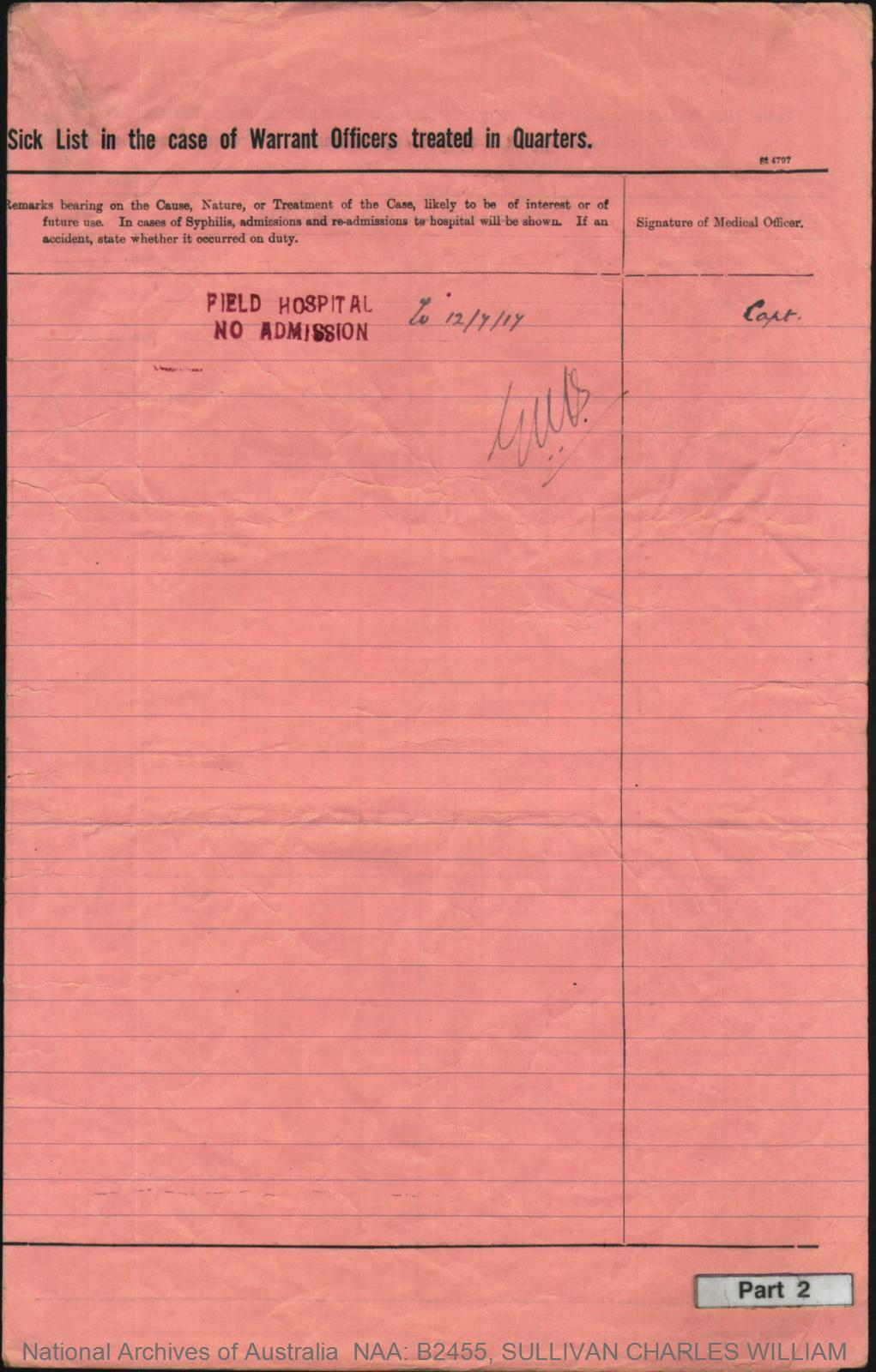
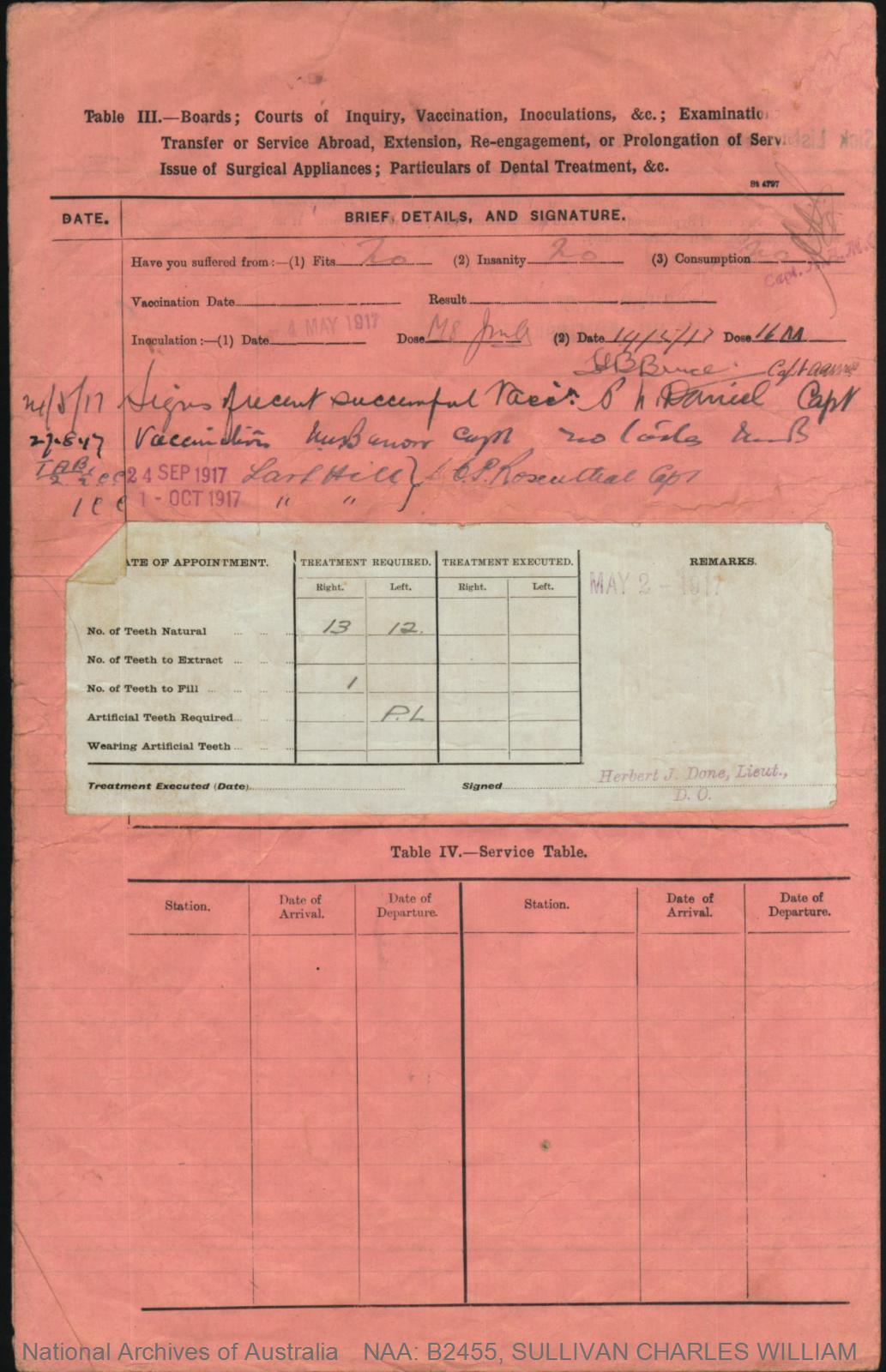

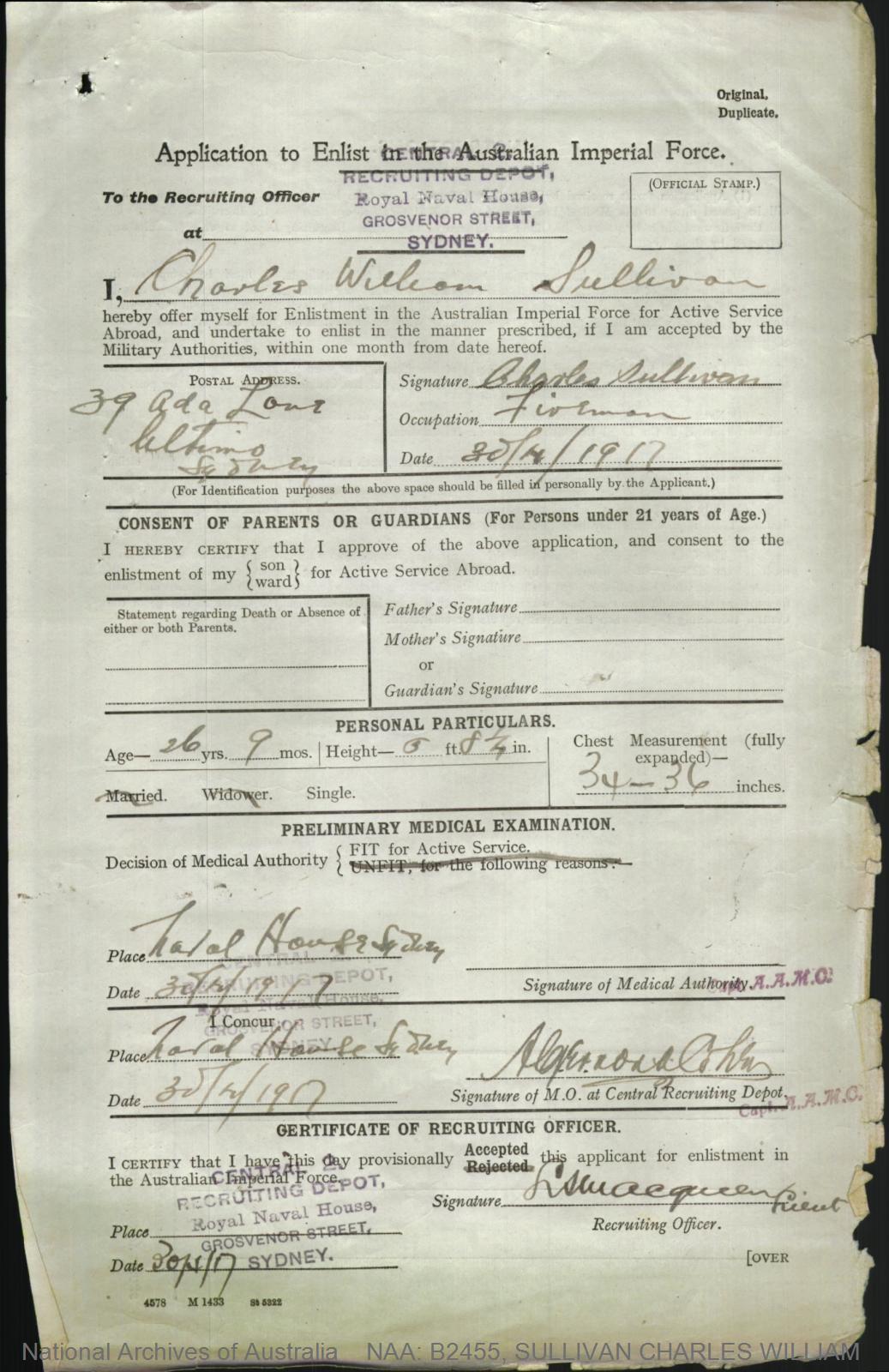
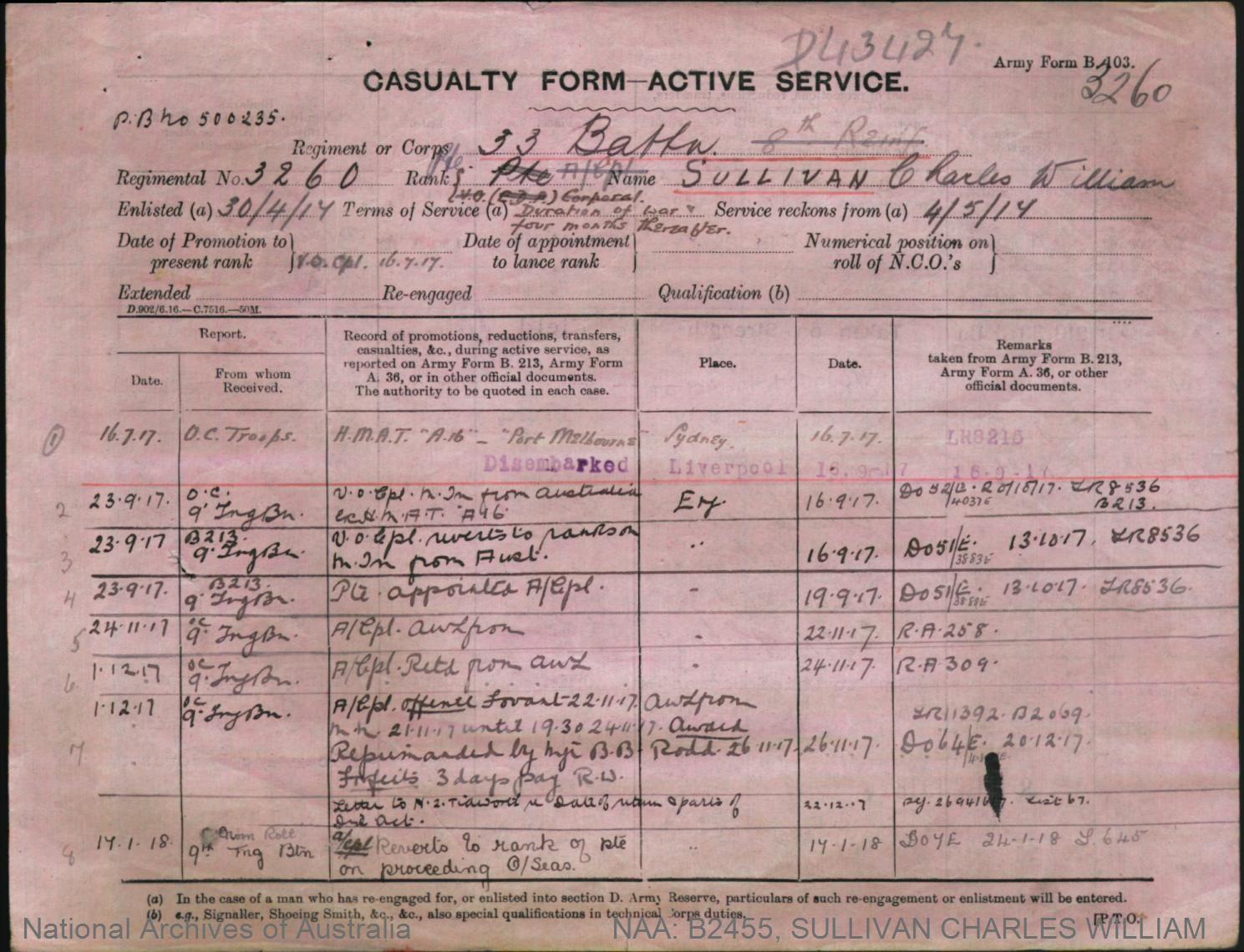

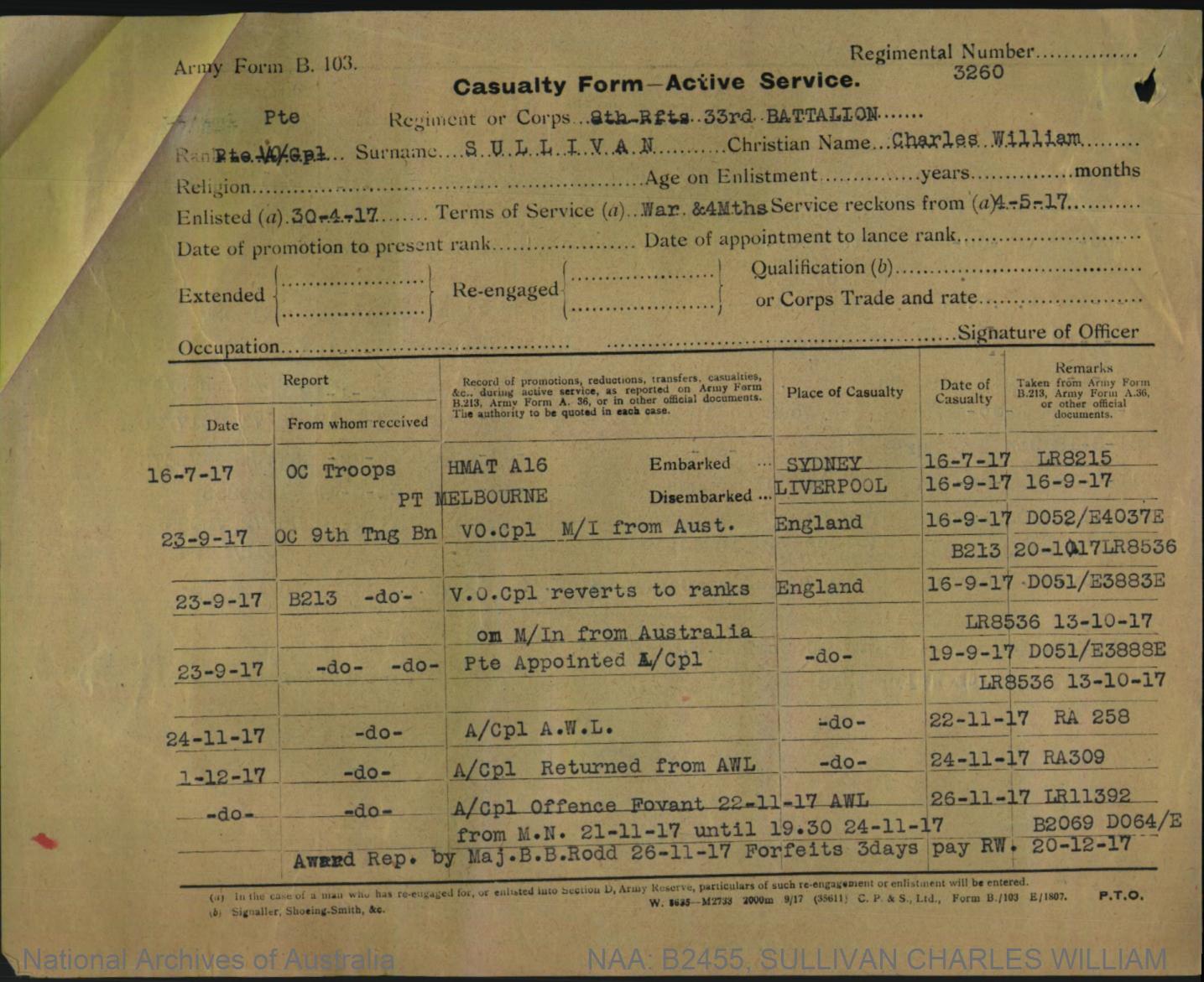
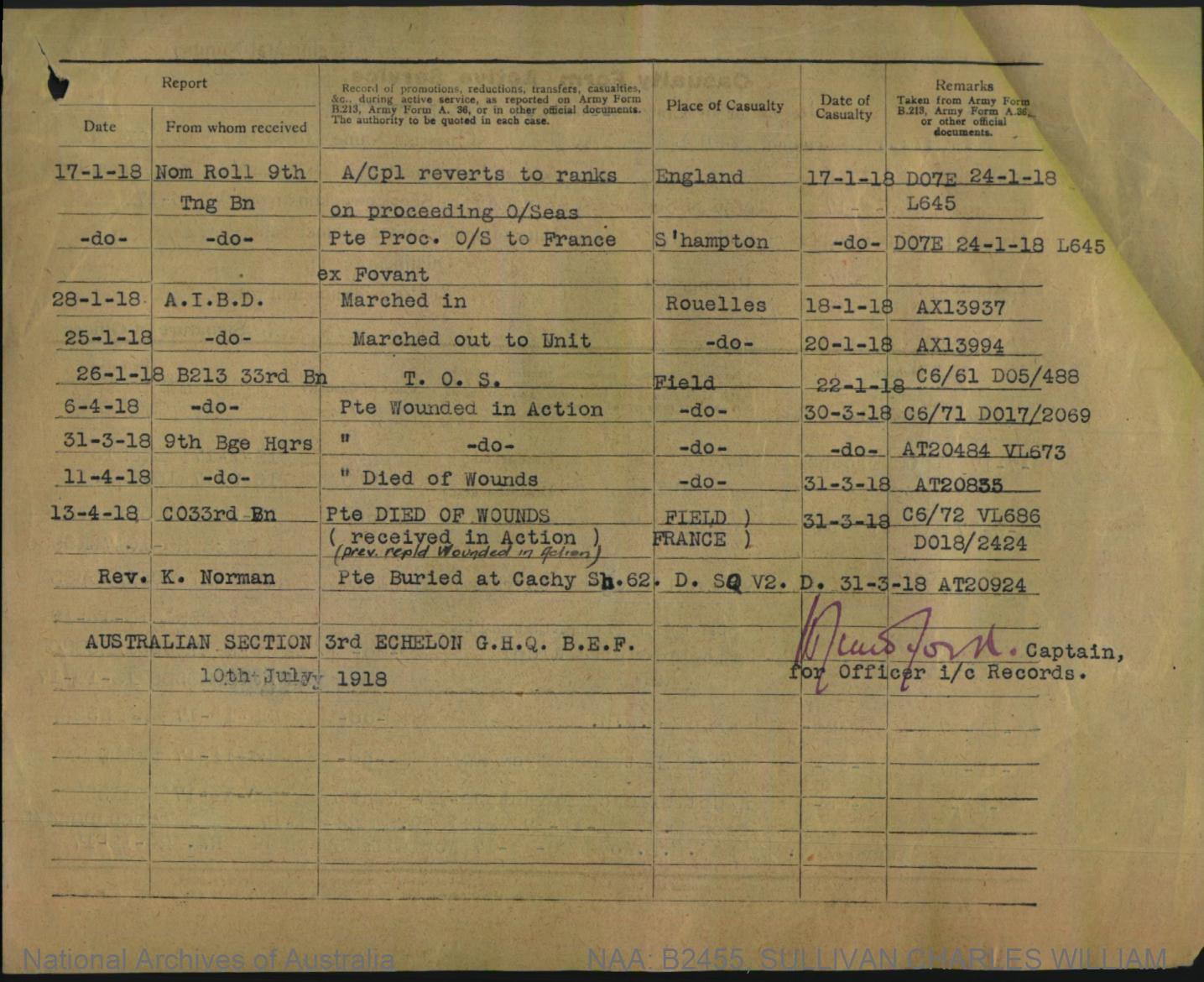
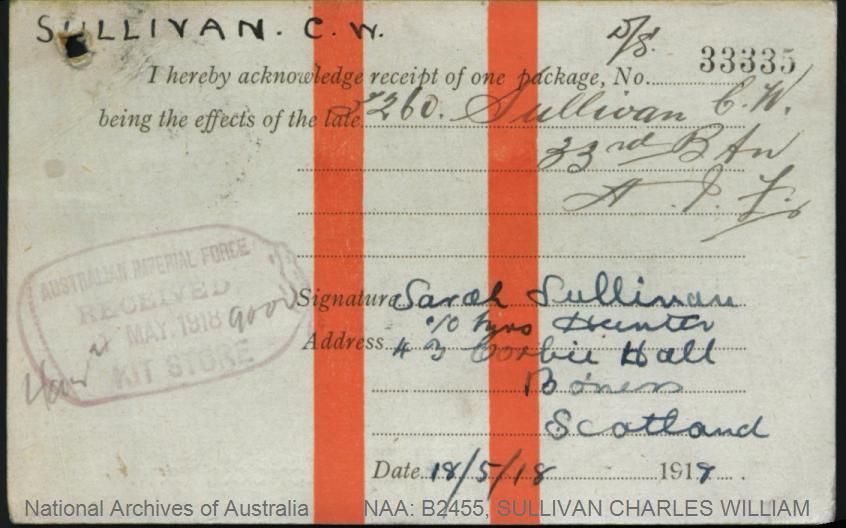
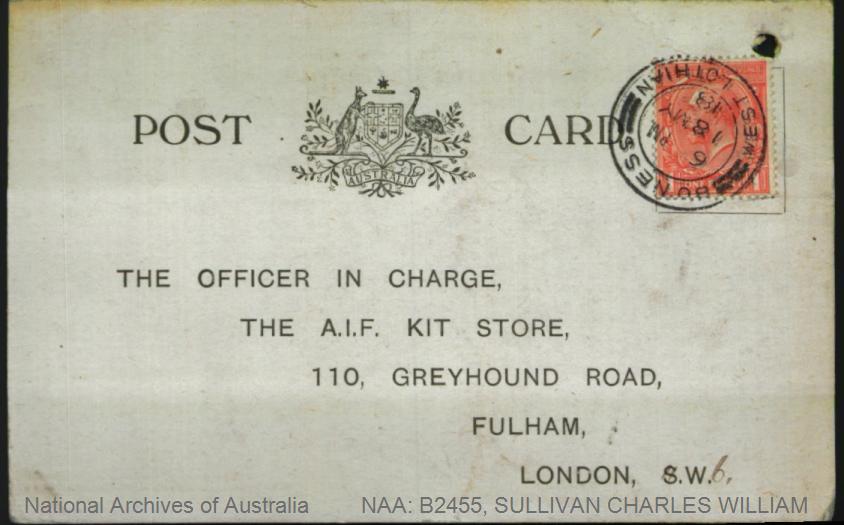
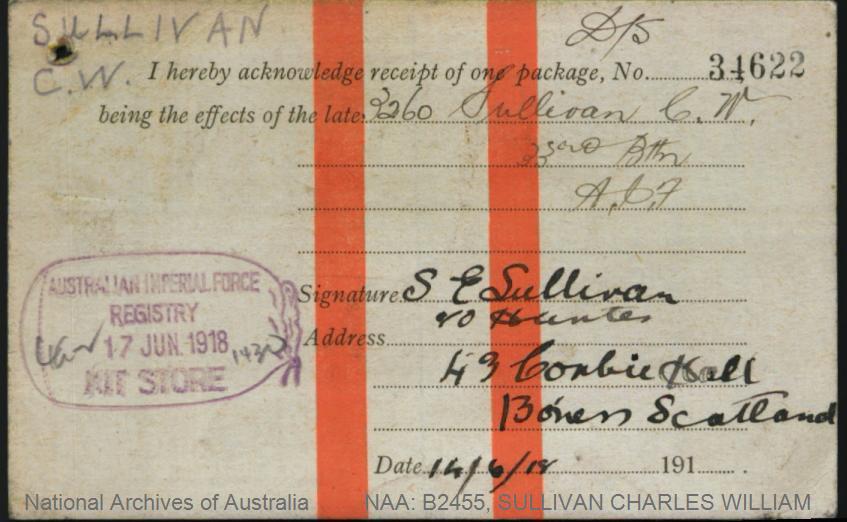
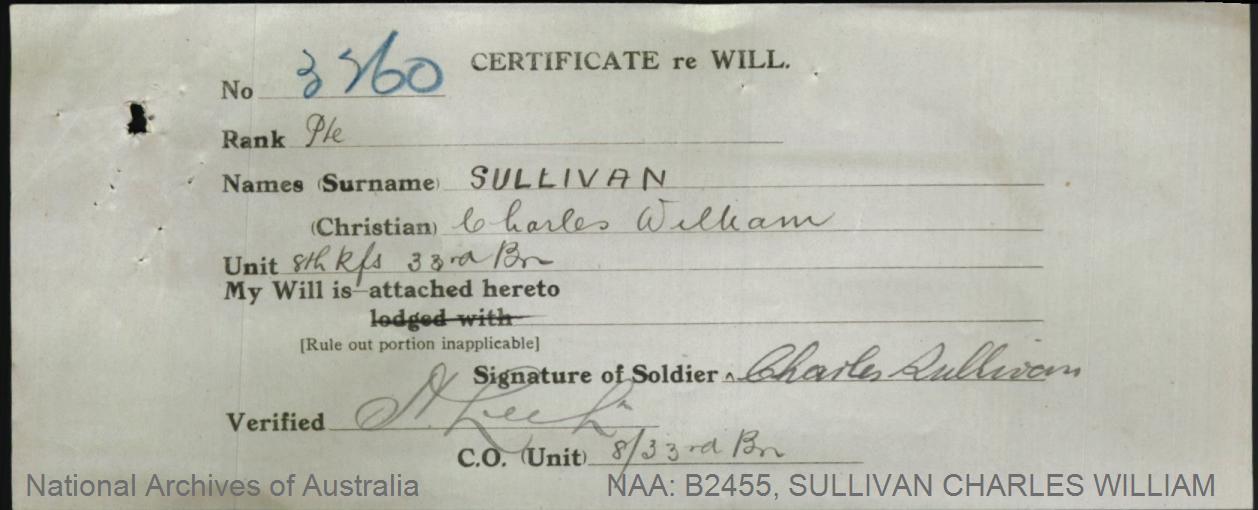
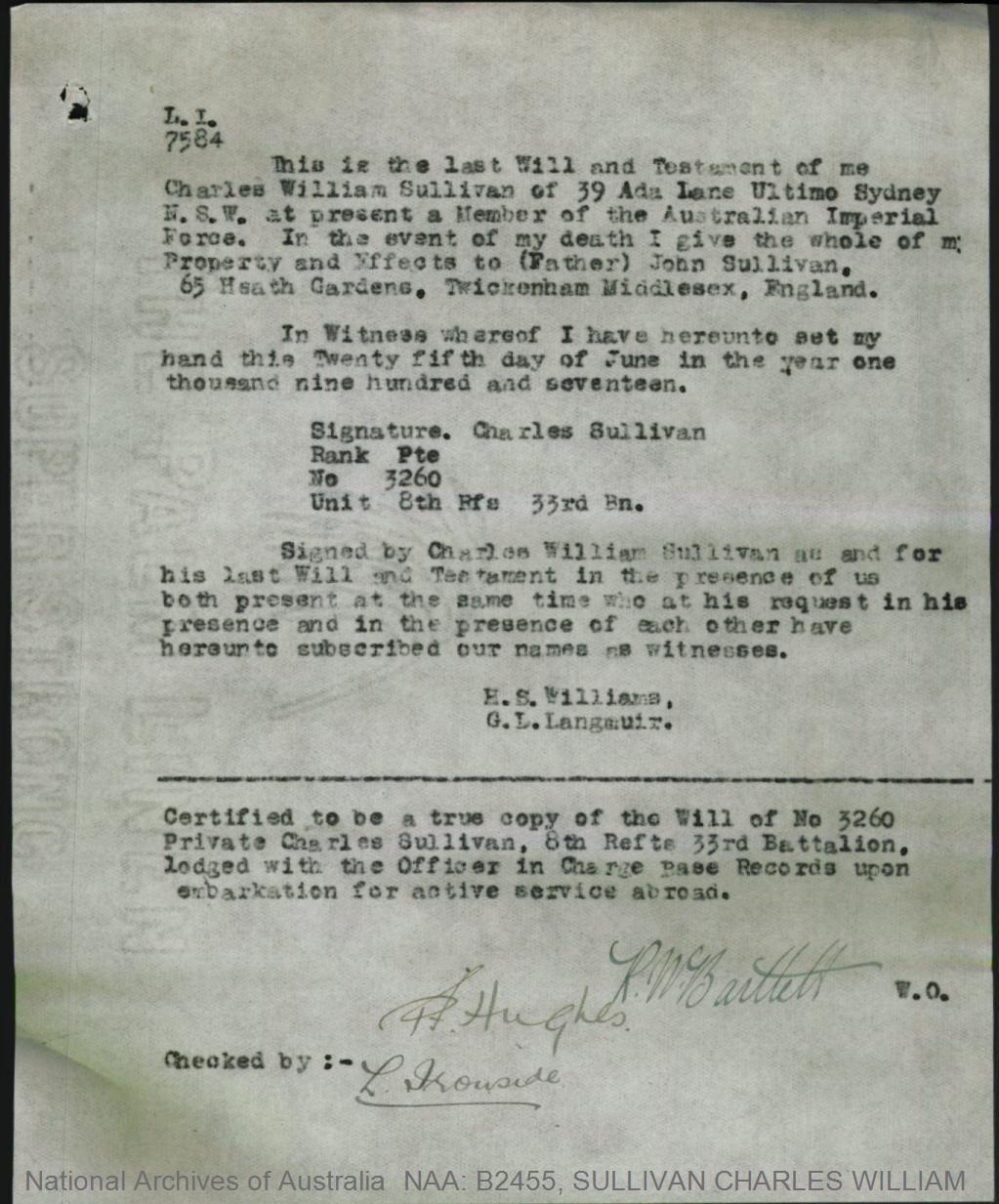
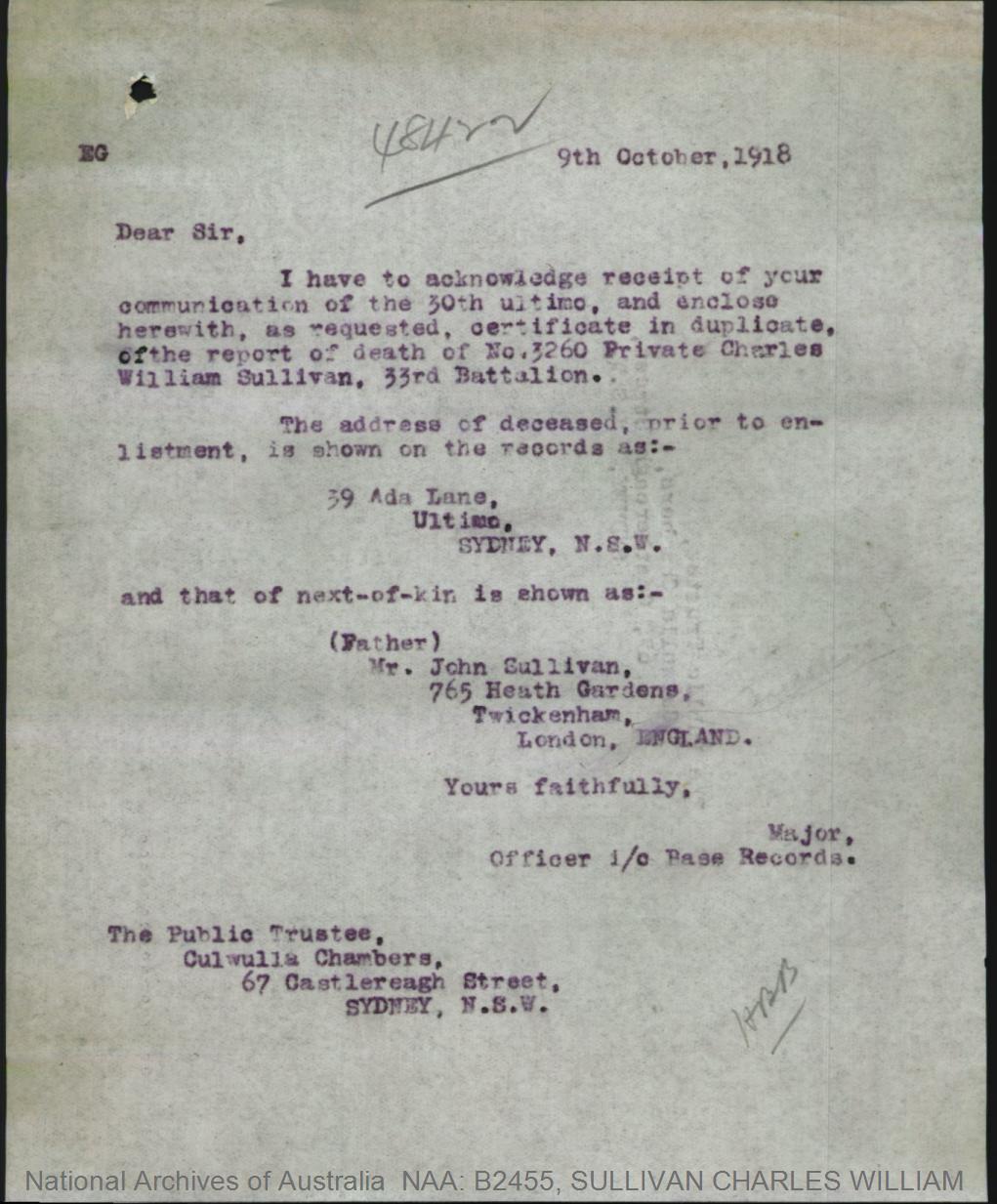
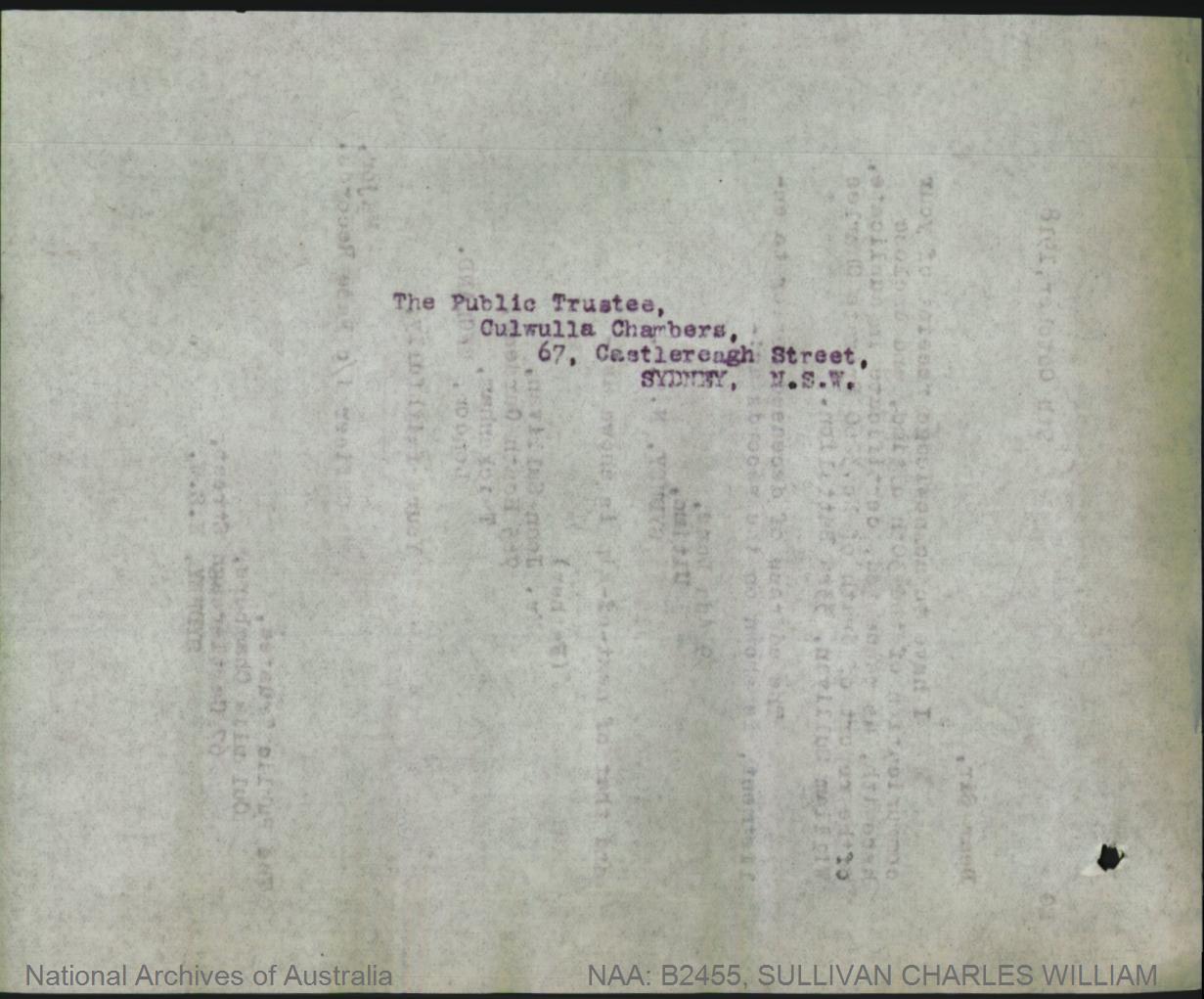
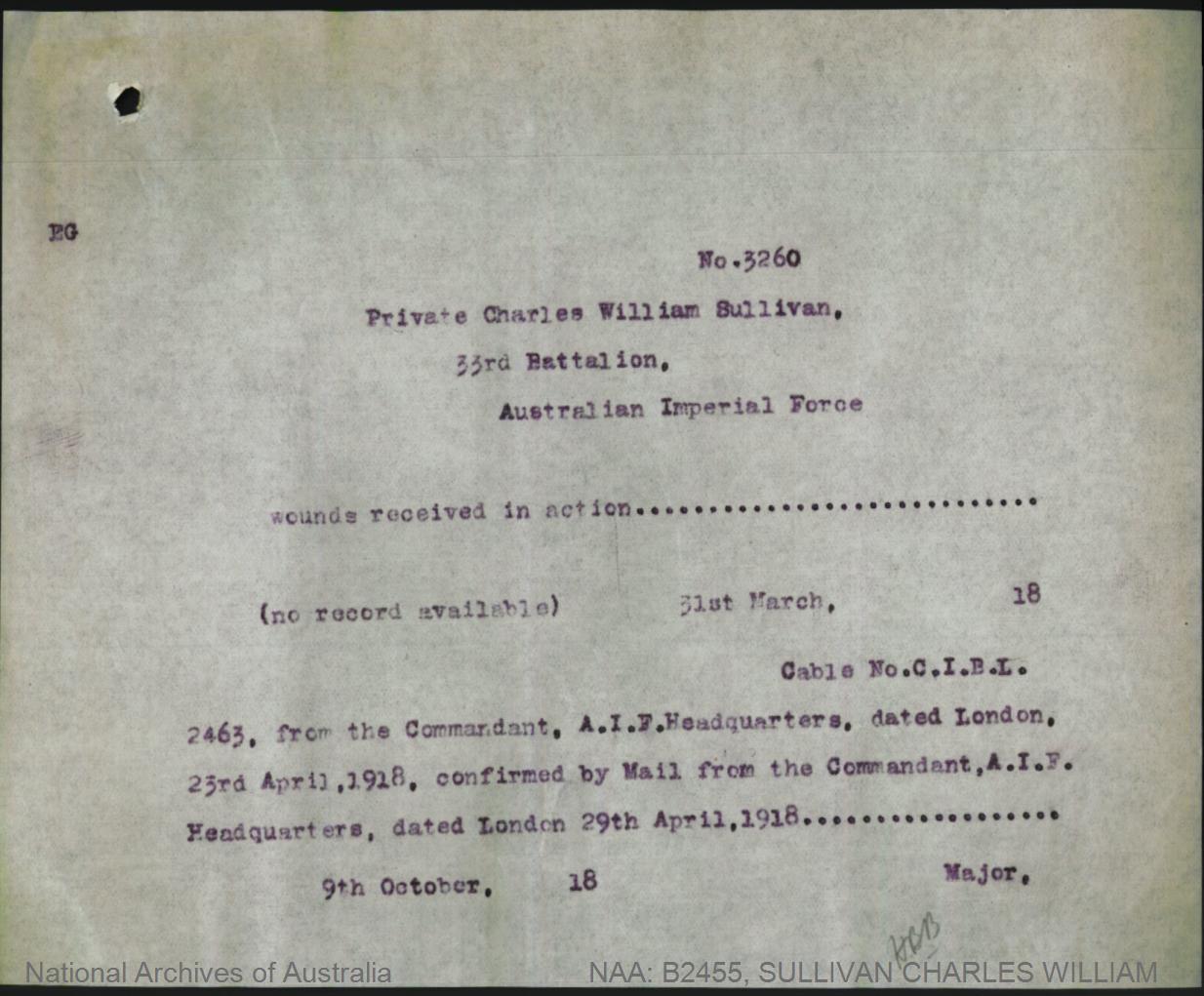
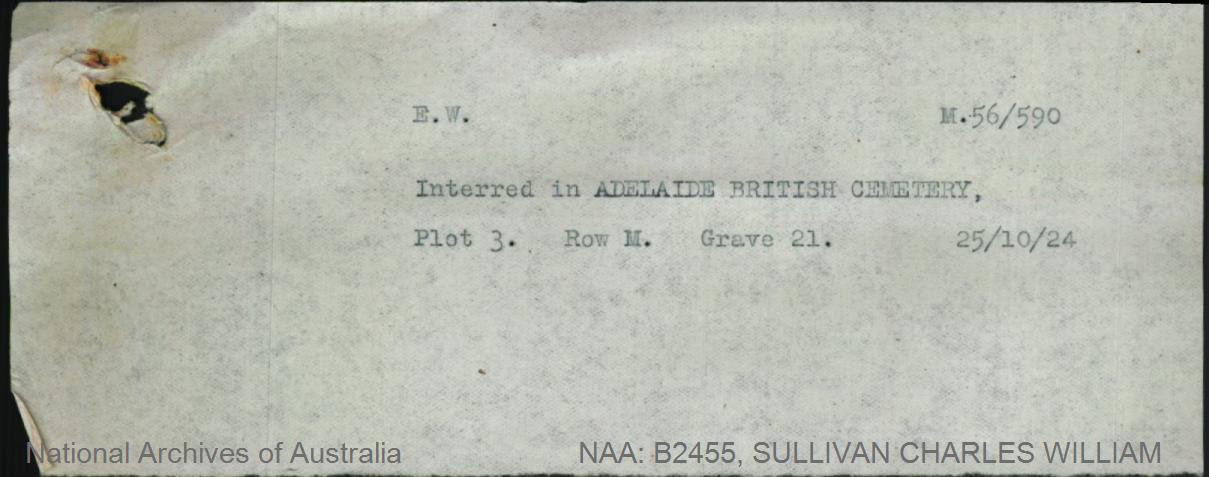
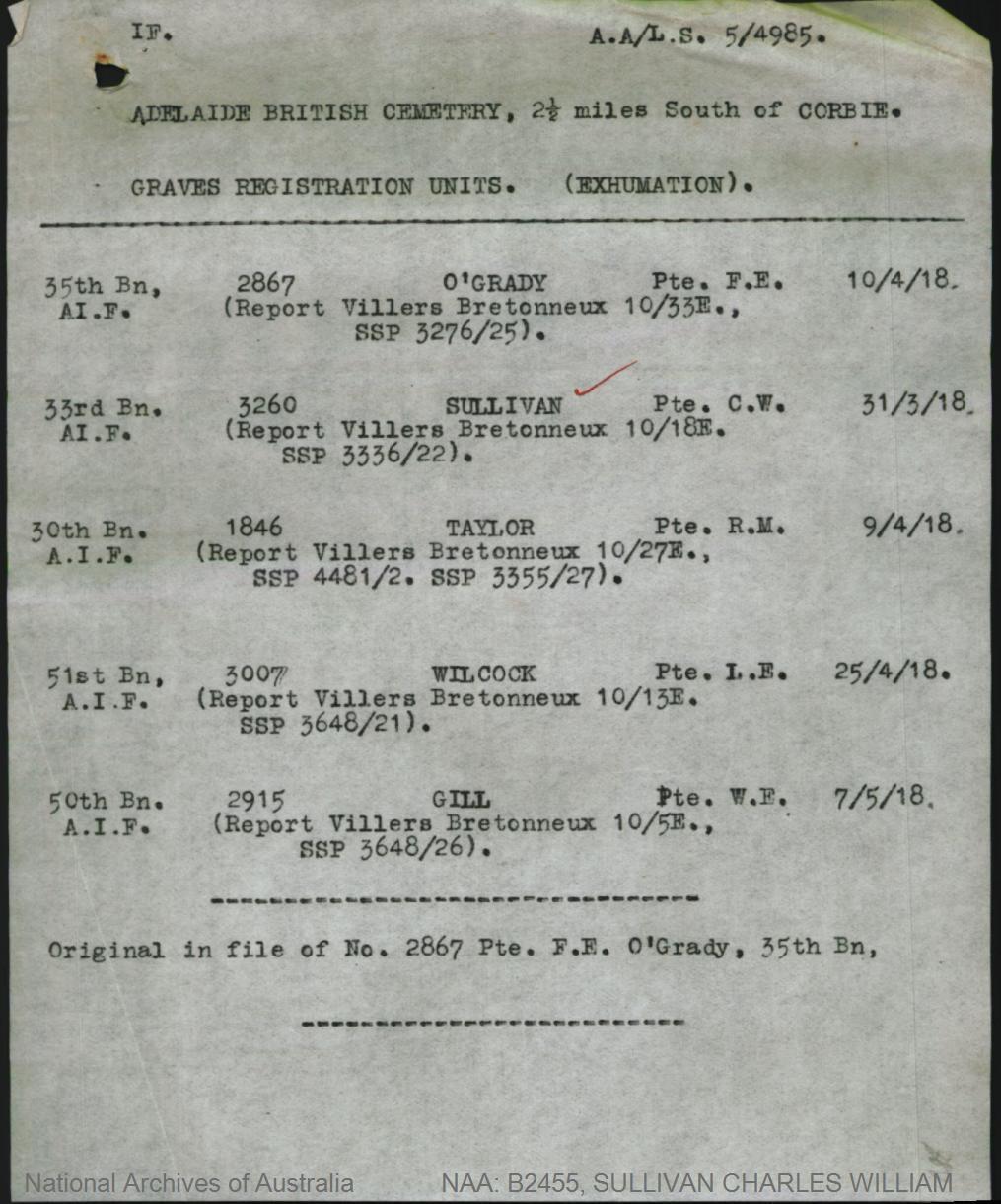
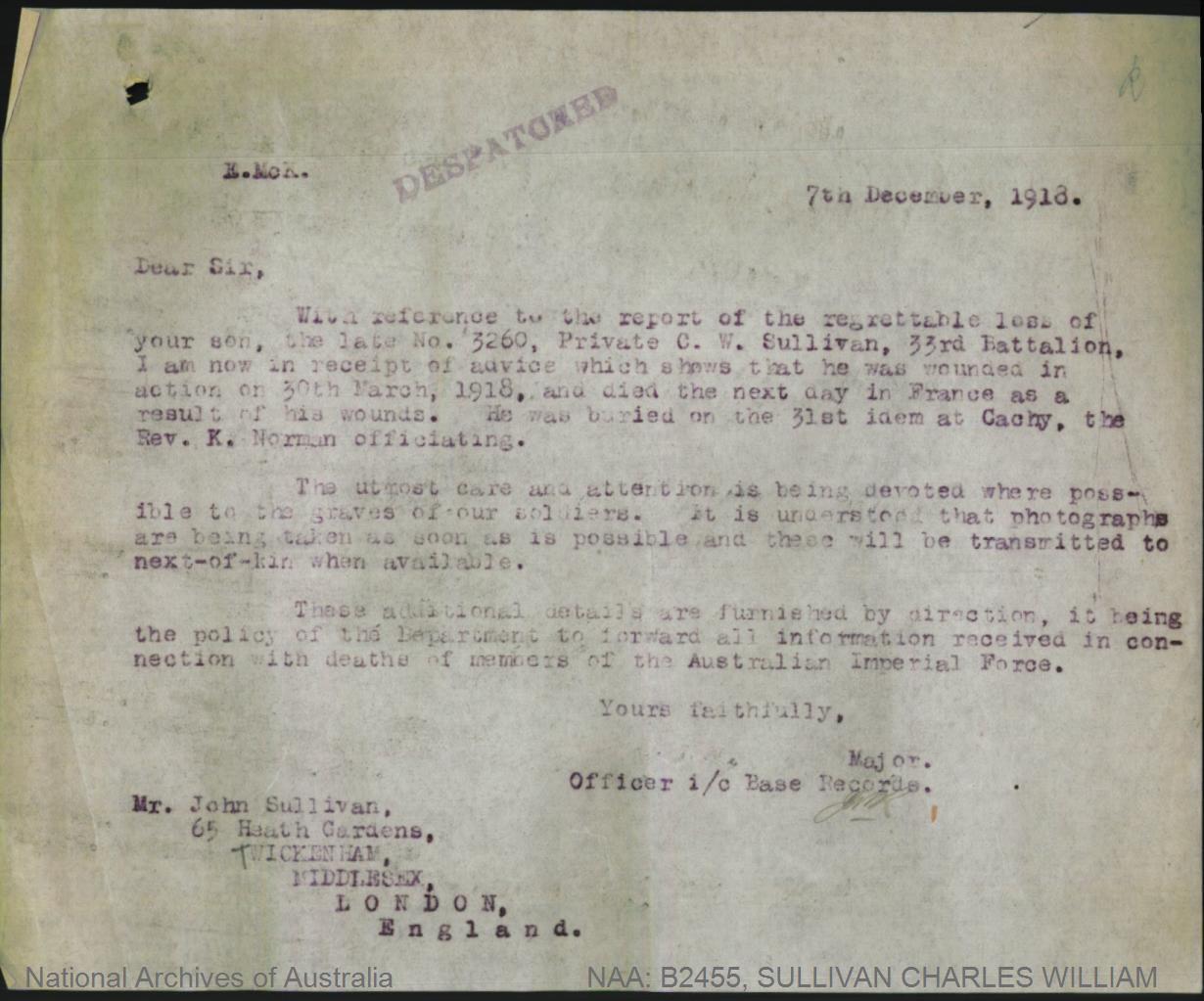
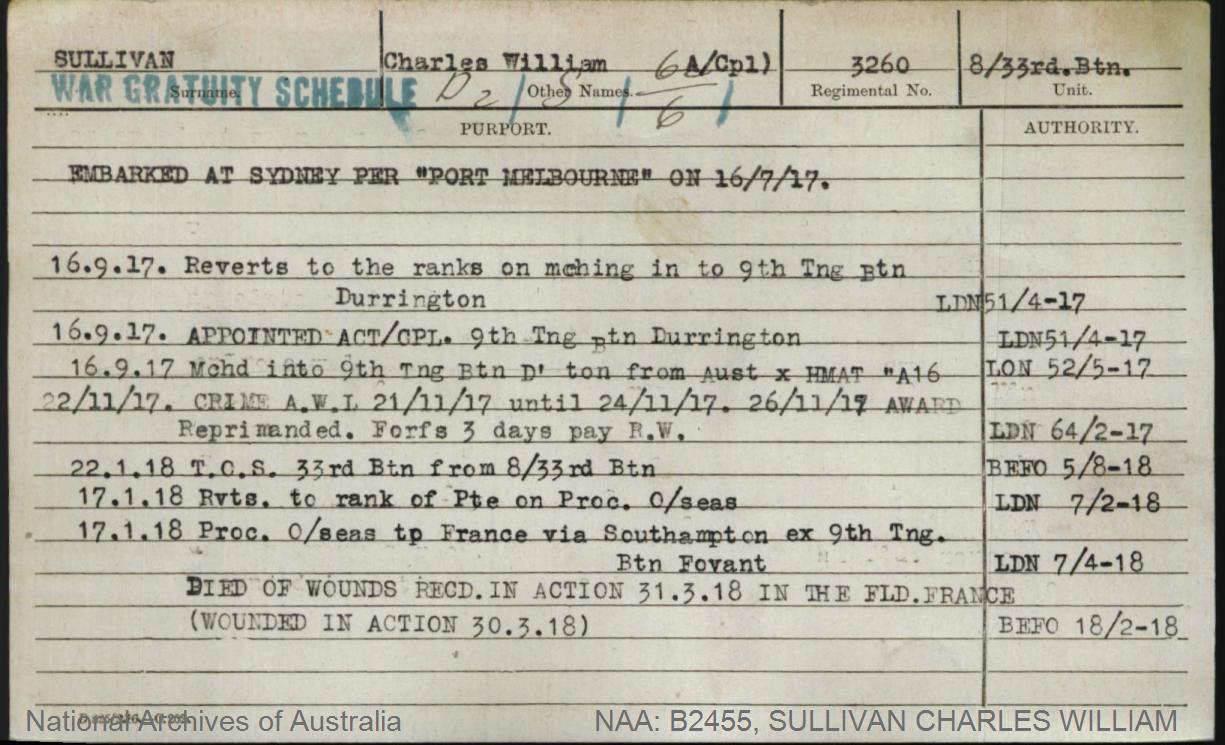



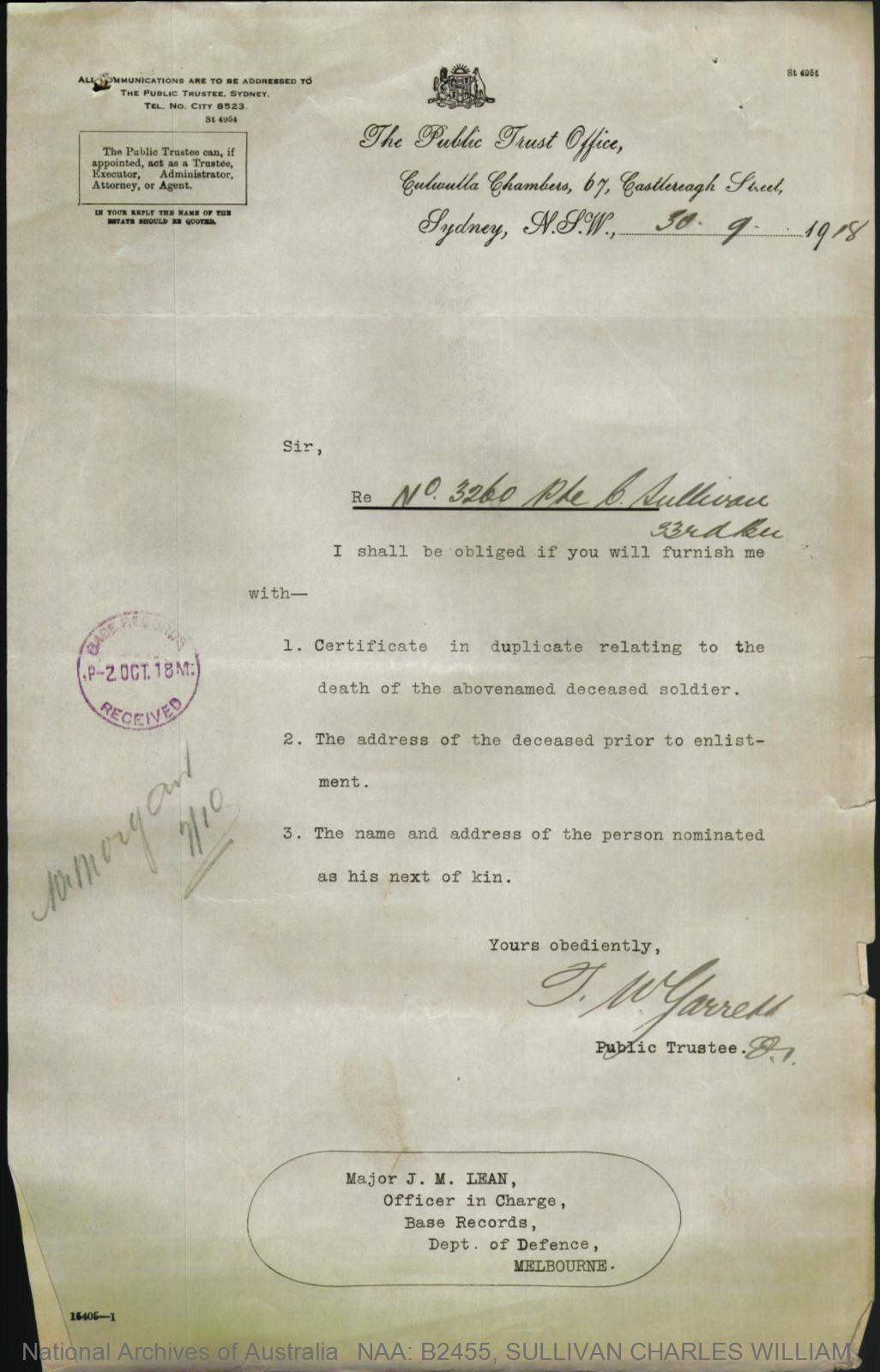




© Commonwealth of Australia (National Archives of Australia)
Under Construction: 05/08/2023.
